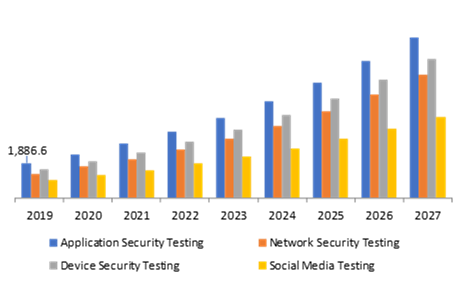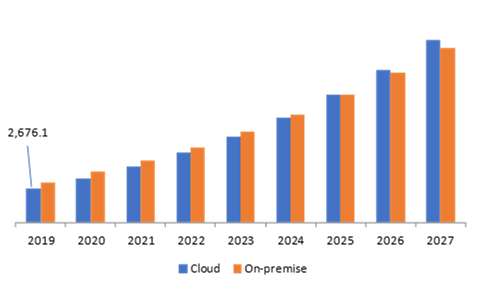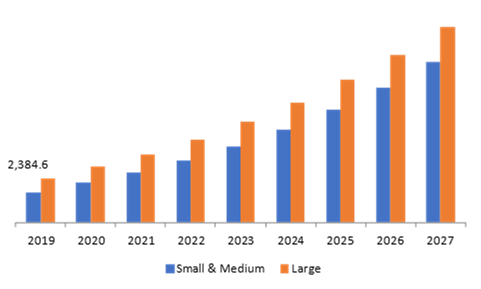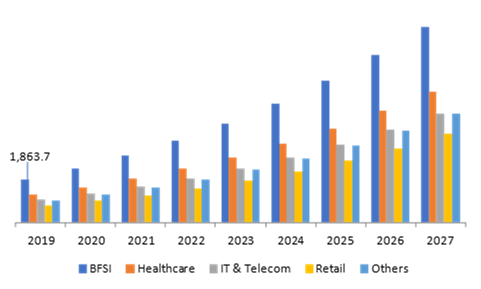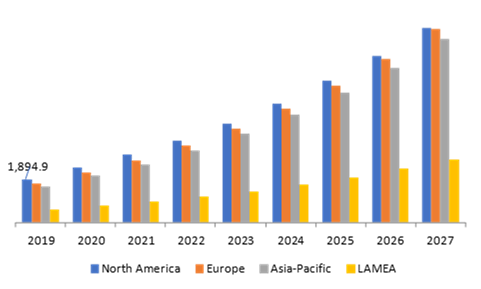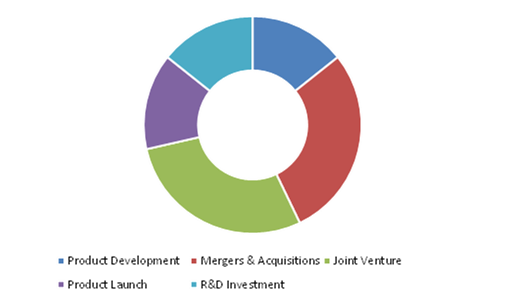Security Testing Market Report
RA00409
Security Testing Market, by Testing Type (Application Security Testing, Network Security Testing, Device Security Testing, Social Media Testing), Deployment (Cloud, On-premise), Organization Size (Small & Medium, Large), Vertical (BFSI, Healthcare, IT & Telecom, Retail, Others), Regional Analysis (North America, Europe, Asia Pacific, LAMEA): Global Opportunity Analysis and Industry Forecast, 2020–2027
The global security testing market forecast shall be $27,593.9 million by 2027, rising from $5,800.0 million in 2019 at a healthy rate of 20.7%. The Asia Pacific security testing market is estimated to increase at a CAGR of 21.4% by generating a revenue of $7,980.2 million, during the projected timeframe. Strategic confederation among the market players along with the launching of advanced security services is expected to accelerate the North America security testing market growth.
Security Testing Market Analysis:
Security testing is a type of software testing that unwraps unsheldibility, intimidation, risks in a security control system, and prevents spiteful attacks from invaders. The main purpose of security tests is to recognize all possible inadequacy and defects of the software network which may result in a dropping of important data, profit, a distinction at the hands of the staff, or outsiders of the company.
Impact Analysis of COVID-19 on the Global Security Testing Market
The global security testing market is reaching a higher growth rate during the outbreak of the COVID-19 pandemic. The pandemic has created boundless challenges for businesses across the globe. Healthcare systems are under tremendous pressure owing to the COVID-19 global pandemic. Healthcare professionals are turning to chat, phones, email, and virtual medicine portals for remote counseling and diagnoses. Thus, to secure these online transactions of payments and conversational data, security testing plays a crucial role all over the healthcare industry.
In addition to this, several companies growing in the security testing market are coming forward with their strategic steps to help society during the COVID-19 chaotic situation. For instance, in April 2020, Automation Anywhere. Inc, a notable player in Robotic Process Automation (RPA), has made an announcement of the release of ‘Bot Security’, the industry’s 1st security platform to set the standard for securing software bots. This innovative tool includes 4 levels of protection such as self-attestation & developer training, threat model & static analysis, malware scan, and penetration testing to address the stringent security concerns. Moving ahead, in September 2020, Secureworks a pioneer in security testing solutions has made an announcement that they have entered into a distribution agreement with Arrow Electronics, a leading technology solutions vendor, to provide Secureworks’ complete service/product portfolio to channel partners across the North America region. The above-stated initiatives and company developments may generate investment opportunities for security testing tools, in the global marketplace, amid the COVID-19 crisis.
Rigorous government regulations to increase the adoption of security testing solutions and services generate remarkable revenue for the global security testing market
The global security testing industry is witnessing massive growth mainly because of the technological innovations along with extensively increasing cybercrime all over the world; thus, to overcome crimes related to security, it requires higher secure endpoint protection. Such key factors may surge the growth of the security testing market, throughout the forecast period. In addition to this, the government supportive policies for cybersecurity may also create a positive impact on the global market for security testing solutions. For instance, in December 2018, the Australian small business and family enterprises Ombudsman (Australian government), initiated the grants process for the ‘Cyber Security Small Business Program’ until June 2020. Small & medium enterprises with 19 or less employees are eligible for a grant to conduct a certified cybersecurity health check to identify business risks and vulnerabilities. These types of government initiatives may lead to an increase in the demand for security testing services in the global market.
To know more about global security testing market drivers, get in touch with our analysts here.
Expensive cyber-security may restrain the growth of the global security testing industry
The higher cost of security testing tools is expected to restrain the growth of the global market, in the forecast period. Moreover, complexities and lack of security testing knowledge were also cited as key issues that create a negative impact on the global security testing market during the forecast period.
The growing prominence on cloud-based security testing and the evolution of technologies may create huge opportunities for the global security testing market, in the future
The security testing market is growing at a very fast pace due to the advancements in cybersecurity. The technological interconnection is shifting to mobile-based or device-based applications along with businesses eagerly acquiring innovative technologies. These are some of the driving factors for the security testing market. In addition, many companies are focusing on a new technology called ‘cloud-based security testing’ which offers centralized protection, cost-effectiveness, minimize administration, and credibility for the higher class of security. Furthermore, the availability of integrated cloud-based security testing tools such as SOASTA CloudTes, LoadStorm, BlazeMeter, Nessus, Jenkins Dev@Cloud, Xamarin test cloud, TestLink, and Watir is further expected to create a positive impact on the global security testing market, throughout the forecast period.
To know more about global security testing market opportunities, get in touch with our analysts here.
Global Security Testing Market, by Testing Type:
Application security testing shall generate a revenue of $8,782.3 million by 2027 mainly because of the superior speed of threat detection and enhanced efficiency
Source: Research Dive Analysis
The network security testing market shall have the fastest market growth and it is anticipated to generate a revenue of $6,751.2 million by 2027, growing from $1,339.0 million in 2019. The growth of the network security testing segment for the global security testing market is mainly attributed to the extensively increased cyber vulnerabilities, across the developed as well as developing countries. The network security testing tool asses the security controls across a network to identify and demonstrate vulnerabilities and determine risks. Owing to these key factors, network security testing tools may have significant market growth in the global market, during the projected period.
However, the application security testing type shall have a dominating market share in the global market and is expected to register a revenue of $8,782.3 million, during the analysis of forecast; an extensively increased malicious activity across the globe has forced enterprises to pay attention to the software vulnerability. Furthermore, key players operating in the global security testing market are adopting strategic collaborations to offer advanced application security testing platforms to businesses. For example, in January 2020, Synopsys has acquired Tinfoil Security, a pioneer in security technologies. Synopsis company has acquired Tinfoil Security in order to strengthen market-leading security portfolios like DAST (Dynamic Application Security Testing) solutions and API testing. These strategic alliances may bolster the growth of segment, during the forecast period.
Global Security Testing Market, by Development Type:
The global cloud segment for the security testing market will have rapid market growth; this is mainly due to its cost-effectiveness and increased adoption in SMEs
Source: Research Dive Analysis
The cloud sub-segment of the global security testing market will have the fastest growth and it is projected to surpass $14,111.7 million by 2027, with an increase from $2,676.1 million in 2019; owing to the extensively increased adoption of cloud-based services, low maintenance costs, and easy set up. Furthermore, the availibilty of highly integrated cloud security testing tools such as amazon cloudwatch, Microsoft cloud monitoring, AppDynamics, and many among others may eventually increase the adoption of the segment, throughout the projected timeframe.
Global Security Testing, by Organization Size:
Small enterprises will have significant growth in the global market; this is mainly because of the growing emphasis on the assessment of cybersecurity vulnerabilities
Source: Research Dive Analysis
The SMEs for the security testing market shall be the fastest growing segment and it is anticipated to generate a revenue of $12,447.1 million by 2027, during the forecast period. Cybercriminals are growing rapidly to attack businesses in different ways such as infringement of data and payment. Hence, companies involved in security testing solutions are coming forward with advanced security testing solutions that provide certain advantages such as exploit vulnerabilities, plunder and pillage sensitive data, and simulate a real-world attack. Such crucial factors may create a significant impact on the security testing platforms for the SME segment, during the forecast timeframe.
However, large business organizations have a dominating market share in the global market and is expected to register a revenue of $15,148.2 million, during the analysis timeframe. Security testing mainly covers a broad range of security aspects such as authentication, authorization, confidentiality, availability, integrity, non-repudiation, and resilience. Furthermore, some of the security testing solution providers are launching novel products to stronghold their position. For instance, on 26 August 2020, GrammaTech, a notable player in security testing solutions, launched its new ‘Swap Detector that detects application programming interface (API) usage errors and improves application security testing for DevOps teams. These advancements may create huge opportunities for the sub-segment, throughout the forecast period.
Global Security Testing Market, by Vertical Type:
The BFSI sub-segment will generate a revenue of $27,594.8 million by 2027, mainly because of its speed, protectivity, and security
Source: Research Dive Analysis
The BFSI security testing is on higher demand and it is expected to generate a remarkable revenue of $8,522.2 million by 2027; this is mainly because of the ability of security testing tools to help monitor defects and hidden bugs that any potential hacker can leverage to get through the client’s data. Furthermore, companies operating in this market are opting for various strategies such as strategic partnership, capacity expansion to help the BFSI players. For example, in March 2020, Veracode, one of the significant independent global providers of best security analyzer, offered its advanced ‘Veracode platform’ to OneSpan Inc., to help secure its solutions coupled with protecting financial institutions and other enterprises from cyber-attacks. Such initiatives may surge the segment growth, throughout the forecast period. However, the retail security testing market shall have the fastest market growth and it is anticipated to generate a revenue of $3,855.6 million by 2027, with a CAGR of 21.8% during the forecast analysis. Owing to the tremendously increased cyber-attacks across the retail sector. For instance, in July 2018, Addidas admitted that a huge data bearing contact information, usernames, and passwords was probably hacked. Furthermore, in November 2019, Macy's, one of the premier retailers across the globe, has admitted that it had suffered a "highly sophisticated and targeted data security incident related to macys.com”. Owing to these incidents, the demand for highly integrated security tools is increased which will ultimately surge the segment growth, throughout the projected period.
Regional Insights:
North America region has a lucrative market and it will reach up to $8,463.0 million by the end of 2027 mainly because of the increment in market players, technological advancements, and their adoptions
Source: Research Dive Analysis
The North America security testing market accounted for $1,894.9 million in 2019 and is projected to register a revenue of $8,463.0 million by 2027. The extensive growth of the North America security testing market is mainly driven by the continuous technological advancements in the region with a high number of early adopters for the technology and the presence of major market players. Moreover, Factors such as the deployment of large scales smart devices such as smartphones, smart television, and smart automobiles and the increment in the adoption of IoT and Artificial Intelligent based technologies increased demand for digitalization and cloud-based security testing, which will ultimately drive the demand of security testing market, across the region.
Asia-Pacific security testing market share is projected to grow at a CAGR of 21.4% by registering revenue of $7,980.2 million by 2027. There has been increasing adoption of security testing solutions among SMEs and large businesses owing to the extensively rising cyber threats. For instance, according to the report published by the Cyber Security Agency of Singapore (CSA) 2019 many organizations in Singapore has at least one infringement in the past 1 year due to outer cyber attacks. The report also stated that they are planning responsively to increase the budget for the security of data for their respective companies in the coming year. These major factors are expected to propel the growth of the market, over the forecast period.
Competitive Scenario in the Global Security Testing Market:
The advanced technology development coupled with mergers & acquisitions are the frequent strategies followed by the significant market players
Source: Research Dive Analysis
Some of the leading security testing market players include IBM, Cisco Systems, SecureWorks, AT&T, Cigniti Technologies Limited, McAfee, Google (Alphabet), Hewlett Packard Enterprise Development LP, F-secure, and Data Theorem, Inc. Security Testing market players are focusing on Merger & acquisition and advanced technical developments. These are the effective strategies followed by the startup as well as established organizations.
Porter’s Five Forces Analysis for Security Testing Market:
- Bargaining Power of Suppliers: The Security testing suppliers are high in number, almost all companies have so many suppliers. Many companies are working on the product design that uses different raw materials so if the price goes high then they have another supplier. So, there will be less threat from the supplier. Thus, the bargaining power of the supplier is Moderate
- Bargaining Power of Buyer: Buyers will have huge bargaining power, they want the best service at low prices. This will increase the pressure on the security test provider to offer the best service in a cost-effective way. Thus, buyers can freely choose the convenient service that best fits their preferences. Thus, the bargaining power of the buyer is HIGH
- The Threat of New Entrants: The companies entering into the security testing market are adopting technological innovations such as developing an innovative software application to attract the customers. Also, these companies are implementing various effective strategies such as offering discounts, value propositions, and many among others. Thus, the threat of the new entrant is Moderate
- The Threat of Substitutes: There is no alternative product for this security testing solutions. Thus, the threat of substitutes is Low
- Competitive Rivalry in the Market: The competitive rivalry among the industry leaders is rather intense, especially between the global players including IBM, Cisco Systems, SecureWorks, and many more companies. These companies are launching their value-added services in the international market and strengthening the footprint worldwide.
Competitive rivalry in the market is High
| Aspect | Particulars |
| Historical Market Estimations | 2018-2019 |
| Base Year for Market Estimation | 2019 |
| Forecast timeline for Market Projection | 2020-2027 |
| Geographical Scope | North America, Europe, Asia-Pacific, LAMEA |
| Segmentation by Testing type |
|
| Segmentation by Development type |
|
| Segmentation by Organization Size |
|
| Key Countries Covered | The U.S., Canada, Mexico, Germany, France, UK, Italy, Spain, Rest of Europe, China, Australia, Japan, India, South Korea, Rest of Asia-Pacific, Latin America, Middle East, and Africa |
| Key Companies Profiled |
|
Q1. What is the size of the global security testing market?
A. The global security testing market size was over $5,800.0 million in 2019 and is projected to reach $27,593.9 million by 2027.
Q2. Which are the major companies in the car rental market?
A. IBM, Cisco Systems, and SecureWorks are some of the key players in the global security testing market.
Q3. Which region possesses greater investment opportunities in the coming future?
A. The Asia-Pacific region possesses great investment opportunities for investors to witness the most promising growth in the future.
Q4. What is the growth rate of the Asia-Pacific Security Testing Market?
A. Asia-Pacific security testing market is anticipated to grow at 21.4% CAGR during the forecast period.
Q5. What are the strategies opted by the leading players in this market?
A. Technological development and strrategic partnerships are the key strategies opted by the operating companies in this market.
Q6. Which companies are investing more on R&D practices?
A. Hewlett Packard Enterprise Development LP and F-secure companies are investing more on R&D activities for developing new products and technologies.
1. Research Methodology
1.1. Desk Research
1.2. Real time insights and validation
1.3. Forecast model
1.4. Assumptions and forecast parameters
1.4.1. Assumptions
1.4.2. Forecast parameters
1.5. Data sources
1.5.1. Primary
1.5.2. Secondary
2. Executive Summary
2.1. 360° summary
2.2. By testing type trends
2.3. By deployment trends
2.4. By organization size trends
2.5. By vertical trends
3. Market Overview
3.1. Market segmentation & definitions
3.2. Key takeaways
3.2.1. Top investment pockets
3.2.2. Top winning strategies
3.3. Porter’s five forces analysis
3.3.1. Bargaining power of consumers
3.3.2. Bargaining power of suppliers
3.3.3. Threat of new entrants
3.3.4. Threat of substitutes
3.3.5. Competitive rivalry in the market
3.4. Market dynamics
3.4.1. Drivers
3.4.2. Restraints
3.4.3. Opportunities
3.5. Technology landscape
3.6. Regulatory landscape
3.7. Patent landscape
3.8. Pricing overview
3.8.1. by Testing Type
3.8.2. by Deployment type
3.8.3. by Organization size type
3.8.4. by vertical type
3.9. Market value chain analysis
3.9.1. Stress point analysis
3.9.2. Raw material analysis
3.9.3. Manufacturing process
3.9.4. Distribution channel analysis
3.9.5. Operating vendors
3.9.5.1. Raw material suppliers
3.9.5.2. Product manufacturers
3.9.5.3. Product distributors
3.10. Strategic overview
4. Security Testing Market, by Testing Type
4.1. Application Security Testing
4.1.1. Market size and forecast, by region, 2019-2027
4.1.2. Comparative market share analysis, 2019 & 2027
4.2. Network Security Testing
4.2.1. Market size and forecast, by region, 2019-2027
4.2.2. Comparative market share analysis, 2019 & 2027
4.3. Device Security Testing
4.3.1. Market size and forecast, by region, 2019-2027
4.3.2. Comparative market share analysis, 2019 & 2027
4.4. Social Media Testing
4.4.1. Market size and forecast, by region, 2019-2027
4.4.2. Comparative market share analysis, 2019 & 2027
5. Security Testing Market, by Deployment
5.1. Cloud
5.1.1. Market size and forecast, by region, 2019-2027
5.1.2. Comparative market share analysis, 2019 & 2027
5.2. On-premise
5.2.1. Market size and forecast, by region, 2019-2027
5.2.2. Comparative market share analysis, 2019 & 2027
6. Security Testing Market, by Organization Size
6.1. Small & Medium
6.1.1. Market size and forecast, by region, 2019-2027
6.1.2. Comparative market share analysis, 2019 & 2027
6.2. Large
6.2.1. Market size and forecast, by region, 2019-2027
6.2.2. Comparative market share analysis, 2019 & 2027
7. Security Testing Market, by Region
7.1. North America
7.1.1. Market size and forecast, by testing type, 2019-2027
7.1.2. Market size and forecast, by deployment, 2019-2027
7.1.3. Market size and forecast, by organization size, 2019-2027
7.1.4. Market size and forecast, by vertical, 2019-2027
7.1.5. Market size and forecast, by country, 2019-2027
7.1.6. Comparative market share analysis, 2019 & 2027
7.1.7. U.S.
7.1.7.1. Market size and forecast, by testing type, 2019-2027
7.1.7.2. Market size and forecast, by deployment, 2019-2027
7.1.7.3. Market size and forecast, by organization size, 2019-2027
7.1.7.4. Market size and forecast, by vertical, 2019-2027
7.1.7.5. Comparative market share analysis, 2019 & 2027
7.1.8. Canada
7.1.8.1. Market size and forecast, by testing type, 2019-2027
7.1.8.2. Market size and forecast, by deployment, 2019-2027
7.1.8.3. Market size and forecast, by organization size, 2019-2027
7.1.8.4. Market size and forecast, by vertical, 2019-2027
7.1.8.5. Comparative market share analysis, 2019 & 2027
7.1.9. Mexico
7.1.9.1. Market size and forecast, by testing type, 2019-2027
7.1.9.2. Market size and forecast, by deployment, 2019-2027
7.1.9.3. Market size and forecast, by organization size, 2019-2027
7.1.9.4. Market size and forecast, by vertical, 2019-2027
7.1.9.5. Comparative market share analysis, 2019 & 2027
7.2. Europe
7.2.1. Market size and forecast, by testing type, 2019-2027
7.2.2. Market size and forecast, by deployment, 2019-2027
7.2.3. Market size and forecast, by organization size, 2019-2027
7.2.4. Market size and forecast, by vertical, 2019-2027
7.2.5. Market size and forecast, by country, 2019-2027
7.2.6. Comparative market share analysis, 2019 & 2027
7.2.7. Germany
7.2.7.1. Market size and forecast, by testing type, 2019-2027
7.2.7.2. Market size and forecast, by deployment, 2019-2027
7.2.7.3. Market size and forecast, by organization size, 2019-2027
7.2.7.4. Market size and forecast, by vertical, 2019-2027
7.2.7.5. Comparative market share analysis, 2019 & 2027
7.2.8. UK
7.2.8.1. Market size and forecast, by testing type, 2019-2027
7.2.8.2. Market size and forecast, by deployment, 2019-2027
7.2.8.3. Market size and forecast, by organization size, 2019-2027
7.2.8.4. Market size and forecast, by vertical, 2019-2027
7.2.8.5. Comparative market share analysis, 2019 & 2027
7.2.9. France
7.2.9.1. Market size and forecast, by testing type, 2019-2027
7.2.9.2. Market size and forecast, by deployment, 2019-2027
7.2.9.3. Market size and forecast, by organization size, 2019-2027
7.2.9.4. Market size and forecast, by vertical, 2019-2027
7.2.9.5. Comparative market share analysis, 2019 & 2027
7.2.10. Spain
7.2.10.1. Market size and forecast, by testing type, 2019-2027
7.2.10.2. Market size and forecast, by deployment, 2019-2027
7.2.10.3. Market size and forecast, by organization size, 2019-2027
7.2.10.4. Market size and forecast, by vertical, 2019-2027
7.2.10.5. Comparative market share analysis, 2019 & 2027
7.2.11. Italy
7.2.11.1. Market size and forecast, by testing type, 2019-2027
7.2.11.2. Market size and forecast, by deployment, 2019-2027
7.2.11.3. Market size and forecast, by organization size, 2019-2027
7.2.11.4. Market size and forecast, by vertical, 2019-2027
7.2.11.5. Comparative market share analysis, 2019 & 2027
7.2.12. Rest of Europe
7.2.12.1. Market size and forecast, by testing type, 2019-2027
7.2.12.2. Market size and forecast, by deployment, 2019-2027
7.2.12.3. Market size and forecast, by organization size, 2019-2027
7.2.12.4. Market size and forecast, by vertical, 2019-2027
7.2.12.5. Comparative market share analysis, 2019 & 2027
7.3. Asia Pacific
7.3.1. Market size and forecast, by testing type, 2019-2027
7.3.2. Market size and forecast, by deployment, 2019-2027
7.3.3. Market size and forecast, by organization size, 2019-2027
7.3.4. Market size and forecast, by vertical, 2019-2027
7.3.5. Market size and forecast, by country, 2019-2027
7.3.6. Comparative market share analysis, 2019 & 2027
7.3.7. China
7.3.7.1. Market size and forecast, by testing type, 2019-2027
7.3.7.2. Market size and forecast, by deployment, 2019-2027
7.3.7.3. Market size and forecast, by organization size, 2019-2027
7.3.7.4. Market size and forecast, by vertical, 2019-2027
7.3.7.5. Comparative market share analysis, 2019 & 2027
7.3.8. India
7.3.8.1. Market size and forecast, by testing type, 2019-2027
7.3.8.2. Market size and forecast, by deployment, 2019-2027
7.3.8.3. Market size and forecast, by organization size, 2019-2027
7.3.8.4. Market size and forecast, by vertical, 2019-2027
7.3.8.5. Comparative market share analysis, 2019 & 2027
7.3.9. Australia
7.3.9.1. Market size and forecast, by testing type, 2019-2027
7.3.9.2. Market size and forecast, by deployment, 2019-2027
7.3.9.3. Market size and forecast, by organization size, 2019-2027
7.3.9.4. Market size and forecast, by vertical, 2019-2027
7.3.9.5. Comparative market share analysis, 2019 & 2027
7.3.10. Rest of Asia Pacific
7.3.10.1. Market size and forecast, by testing type, 2019-2027
7.3.10.2. Market size and forecast, by deployment, 2019-2027
7.3.10.3. Market size and forecast, by organization size, 2019-2027
7.3.10.4. Market size and forecast, by vertical, 2019-2027
7.3.10.5. Comparative market share analysis, 2019 & 2027
7.4. LAMEA
7.4.1. Market size and forecast, by testing type, 2019-2027
7.4.2. Market size and forecast, by deployment, 2019-2027
7.4.3. Market size and forecast, by organization size, 2019-2027
7.4.4. Market size and forecast, by vertical, 2019-2027
7.4.5. Market size and forecast, by country, 2019-2027
7.4.6. Comparative market share analysis, 2019 & 2027
7.4.7. Latin America
7.4.7.1. Market size and forecast, by testing type, 2019-2027
7.4.7.2. Market size and forecast, by deployment, 2019-2027
7.4.7.3. Market size and forecast, by organization size, 2019-2027
7.4.7.4. Market size and forecast, by vertical, 2019-2027
7.4.7.5. Comparative market share analysis, 2019 & 2027
7.4.8. Middle East
7.4.8.1. Market size and forecast, by testing type, 2019-2027
7.4.8.2. Market size and forecast, by deployment, 2019-2027
7.4.8.3. Market size and forecast, by organization size, 2019-2027
7.4.8.4. Market size and forecast, by vertical, 2019-2027
7.4.8.5. Comparative market share analysis, 2019 & 2027
7.4.9. Africa
7.4.9.1. Market size and forecast, by testing type, 2019-2027
7.4.9.2. Market size and forecast, by deployment, 2019-2027
7.4.9.3. Market size and forecast, by organization size, 2019-2027
7.4.9.4. Market size and forecast, by vertical, 2019-2027
7.4.9.5. Comparative market share analysis, 2019 & 2027
8. Company Profiles
8.1. IBM
8.1.1. Business overview
8.1.2. Financial performance
8.1.3. Product portfolio
8.1.4. Recent strategic moves & developments
8.1.5. SWOT analysis
8.2. Cisco Systems
8.2.1. Business overview
8.2.2. Financial performance
8.2.3. Product portfolio
8.2.4. Recent strategic moves & developments
8.2.5. SWOT analysis
8.3. SecureWorks
8.3.1. Business overview
8.3.2. Financial performance
8.3.3. Product portfolio
8.3.4. Recent strategic moves & developments
8.3.5. SWOT analysis
8.4. AT&T
8.4.1. Business overview
8.4.2. Financial performance
8.4.3. Product portfolio
8.4.4. Recent strategic moves & developments
8.4.5. SWOT analysis
8.5. McAfee
8.5.1. Business overview
8.5.2. Financial performance
8.5.3. Product portfolio
8.5.4. Recent strategic moves & developments
8.5.5. SWOT analysis
8.6. Google (Alphabet)
8.6.1. Business overview
8.6.2. Financial performance
8.6.3. Product portfolio
8.6.4. Recent strategic moves & developments
8.6.5. SWOT analysis
8.7. Hewlett Packard Enterprise Development LP
8.7.1. Business overview
8.7.2. Financial performance
8.7.3. Product portfolio
8.7.4. Recent strategic moves & developments
8.7.5. SWOT analysis
8.8. F-secure
8.8.1. Business overview
8.8.2. Financial performance
8.8.3. Product portfolio
8.8.4. Recent strategic moves & developments
8.8.5. SWOT analysis
8.9. Data Theorem, Inc.
8.9.1. Business overview
8.9.2. Financial performance
8.9.3. Product portfolio
8.9.4. Recent strategic moves & developments
8.9.5. SWOT analysis
8.10. Cigniti Technologies Limited
8.10.1. Business overview
8.10.2. Financial performance
8.10.3. Product portfolio
8.10.4. Recent strategic moves & developments
8.10.5. SWOT analysis
Security testing is a process that helps in unveiling all the possible vulnerabilities and loopholes in a system which might result in cyber-attack or data breach.
Here are some of the factors that are contributing to the growth of the market:
Numerous cybercrimes are being reported all over the world since the internet has taken over the businesses. To overcome such crimes related to data security, higher secure endpoint protection is required. The latest technological advances and product development by the leading market players are ensuring and safeguarding the businesses from such risks.
In addition, the governments are introducing supportive policies for cybersecurity which is also expected create a positive impact on the global security testing market. In December 2018, the small business and family enterprises Ombudsman of the Australian government has initiated the grants process for the ‘Cyber Security Small Business Program’ until June 2020. Small & medium enterprises with 19 or less employees are eligible for a grant to conduct a certified cybersecurity health check to identify business risks and vulnerabilities. Such initiatives by the governments will definitely drive the growth of security testing services in the global market.
Developments during the Pandemic
It’s quite relevant that the global security testing market is speculating to a higher growth rate during the COVID-19 pandemic. During the critical time, the healthcare professionals are taking the convenience of using smartphones, email, and virtual medicine portals for remote counseling and better and accurate diagnoses. Security testing is playing an essential role in this industry to ensure the security of such online transactions and conversational data.
Many leading companies of the security testing market are coming forward with their strategic approaches. For instance, Automation Anywhere. Inc, a noteworthy player in Robotic Process Automation (RPA) announced of the release of ‘Bot Security’, the industry’s 1st security platform to set the standard for securing software bots in April, 2020. This innovative tool includes 4 levels of protection such as self-attestation & developer training, threat model & static analysis, malware scan, and penetration testing to address the stringent security concerns.
Recent Advances in the Market
According to a recent report published by Research Dive, the key players of the global security testing market include Cigniti Technologies Limited, Cisco Systems, IBM, SecureWorks, AT&T, Google (Alphabet), and Data Theorem Inc., Hewlett Packard Enterprise Development LP, F-secure, McAfee, and many others.
These market players are converging on developing unique strategies including mergers and acquisitions, product launches, upgradation of existing technology, and collaborations and partnerships to sustain the market competition.
Some of the recent developments that have fuelled the growth of the market are mentioned below:
- In September 2020, Secureworks, a global leader in security testing solutions has made a statement about them initiating a distribution agreement with Arrow Electronics, another leading technology solutions vendor. The agreement aimed to provide the complete service/product portfolio of Secureworks to the channel partners across the North America region.
- In August 2020, GrammaTech, a notable player in security testing solutions, has launched its new ‘Swap Detector; that detects application programming interface (API) usage errors and improves application security testing for DevOps teams.
- In March 2020, Veracode, one of the significant independent global providers of the best security analyzer has offered its advanced ‘Veracode platform’ to OneSpan Inc., to help secure its solutions along with protecting financial institutions and other enterprises from cyber-attacks.
- As per a recent report, Secureworks has acquired Delve to bring a new vulnerability management solution to the firm's portfolio. Delve is a vulnerability management platform based on Machine Learning and Artificial Intelligence.
- According to another press release, Cigniti Technologies Limited has recently announced about its acquisition of Gallop Solutions Inc, a specialized software testing services company based on USA. Cigniti Technologies Limited is the largest independent software testing services company in India.
- Google has recently acquired StratoZone to help partners and customers strategize and automate data center migrations to Google Cloud Platform. StratoZone provides the cloud migration needs for its clients.
- Another development has been offered by Data Theorem, Inc., a leading provider of modern application security. The company has recently launched Web Secure, the first full-stack application security analyzer of the company. Web Secure will provide vulnerability analysis for modern web applications from the web-layer down to its embedded APIs and cloud resources.
Conclusion
The developmental strategies taken by the leading market players are helping the security testing market to garner a promising revenue. The increasing incidents of cybercrimes will enhance the demand of the security testing market in upcoming years.
Personalize this research
- Triangulate with your own data
- Request your format and definition
- Get a deeper dive on a specific application, geography, customer or competitor
- + 1-888-961-4454 Toll - Free
- support@researchdive.com

